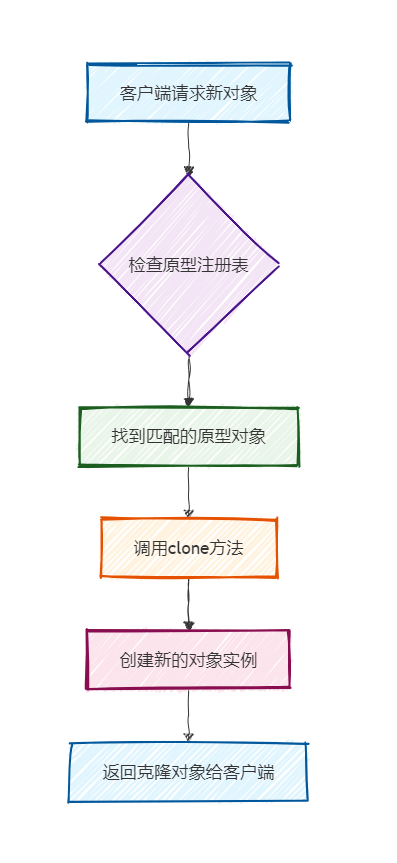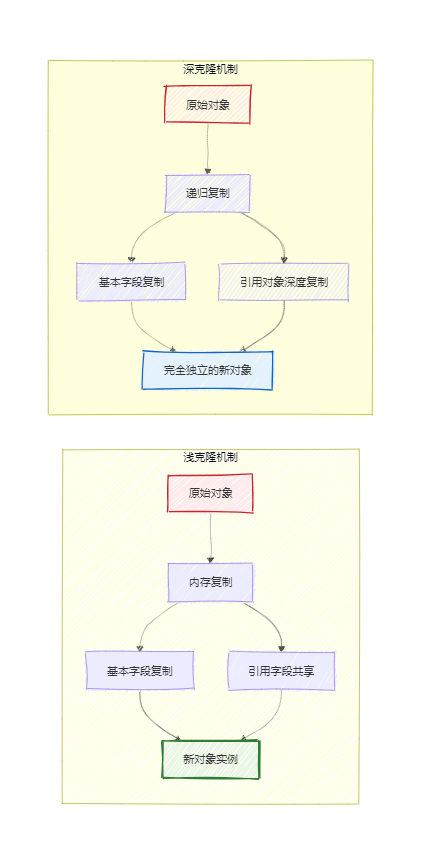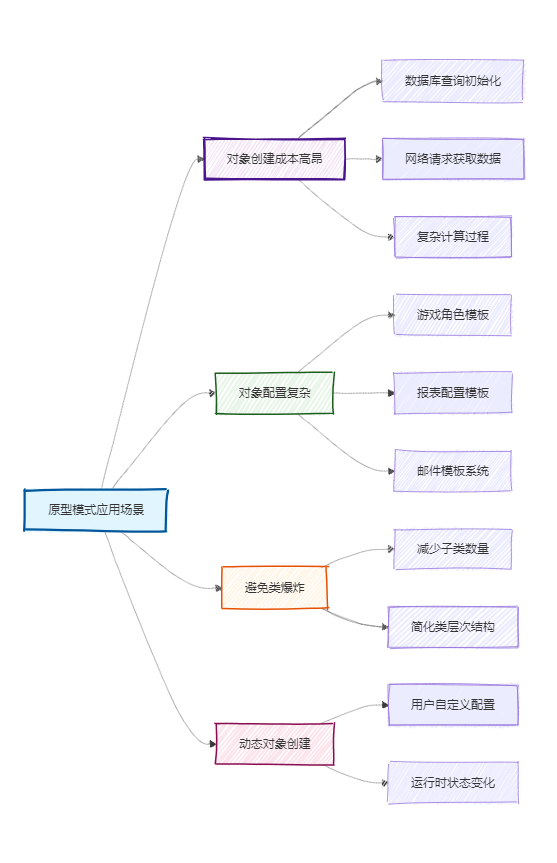原型模式深度解析:Java设计模式实战指南与克隆机制优化实践
作者简介
我是摘星,一名全栈开发者,专注 Java后端开发、AI工程化 与 云计算架构 领域,擅长Python技术栈。热衷于探索前沿技术,包括大模型应用、云原生解决方案及自动化工具开发。日常深耕技术实践,乐于分享实战经验与学习心得,希望用通俗易懂的方式帮助开发者快速掌握核心技术。持续输出AI、云计算及开源技术相关内容
1. 技术背景
在现代软件开发中,对象创建是一个核心且频繁的操作。随着系统复杂度的增加,传统的对象创建方式(如直接使用new关键字)在某些场景下会遇到显著的性能瓶颈和灵活性限制。特别是当需要创建大量相似对象、对象初始化成本较高、或者需要根据运行时状态动态创建对象时,传统创建方式显得力不从心。
原型模式作为GoF设计模式中的一种重要创建型模式,为这些挑战提供了优雅而高效的解决方案。它通过克隆现有对象来创建新对象,避免了复杂的初始化过程,同时提供了更好的性能表现和更高的灵活性。
在企业级应用开发中,原型模式被广泛应用于对象池管理、缓存系统设计、配置对象复制、游戏开发中的角色复制,以及文档编辑器中的操作撤销/重做功能等多个领域。
2. 概念定义
2.1 原型模式定义
原型模式(Prototype Pattern)是一种创建型设计模式,它通过复制现有的实例来创建新的实例,而不是通过实例化类来创建。这种模式特别适用于创建复杂对象或者创建成本较高的对象。
2.2 核心组成要素
原型模式主要包含以下几个核心要素:
- 原型接口(Prototype):声明克隆方法的接口
- 具体原型(ConcretePrototype):实现克隆方法的具体类
- 客户端(Client):使用原型对象进行克隆操作的类
2.3 克隆类型
原型模式中的克隆分为两种类型:
- 浅克隆(Shallow Clone):只复制对象的基本字段,对象字段仍然指向原对象
- 深克隆(Deep Clone):完全复制对象及其所有嵌套对象
3. 原理剖析
3.1 工作机制
原型模式的工作机制基于对象克隆技术。当需要创建新对象时,不是通过类的构造函数,而是通过复制已存在的对象实例。这个过程涉及到Java中的Cloneable接口和clone()方法

图1 原型模式工作流程图
3.2 内存分配机制
在原型模式中,对象的创建过程绕过了构造函数,直接在内存中复制对象的二进制数据。这种机制使得对象创建速度更快,特别是对于包含复杂初始化逻辑的对象。
图2 原型模式内存分配机制图

4. 技术实现
4.1 基础原型接口实现
/**
* 原型接口定义
* 所有需要支持克隆的类都应该实现此接口
*/
public interface Prototype extends Cloneable {
/**
* 克隆方法
* @return 克隆后的对象
* @throws CloneNotSupportedException 克隆异常
*/
Prototype clone() throws CloneNotSupportedException;
}4.2 具体原型类实现
import java.util.ArrayList;
import java.util.List;
/**
* 具体原型类:员工信息
* 演示浅克隆和深克隆的实现
*/
public class Employee implements Prototype {
private String name;
private int age;
private String department;
private List<String> skills;
private Address address;
public Employee(String name, int age, String department) {
this.name = name;
this.age = age;
this.department = department;
this.skills = new ArrayList<>();
this.address = new Address();
// 模拟复杂的初始化过程
System.out.println("正在初始化员工对象:" + name);
simulateComplexInitialization();
}
/**
* 模拟复杂初始化过程
*/
private void simulateComplexInitialization() {
try {
Thread.sleep(50); // 模拟耗时操作
} catch (InterruptedException e) {
Thread.currentThread().interrupt();
}
}
/**
* 浅克隆实现
* 只复制基本字段,引用字段共享
*/
@Override
public Employee clone() throws CloneNotSupportedException {
System.out.println("执行浅克隆操作:" + this.name);
return (Employee) super.clone();
}
/**
* 深克隆实现
* 完全复制所有字段,包括引用对象
*/
public Employee deepClone() throws CloneNotSupportedException {
System.out.println("执行深克隆操作:" + this.name);
// 首先进行浅克隆
Employee cloned = (Employee) super.clone();
// 深度复制引用对象
cloned.skills = new ArrayList<>(this.skills);
cloned.address = this.address.clone();
return cloned;
}
// Getter和Setter方法
public String getName() { return name; }
public void setName(String name) { this.name = name; }
public List<String> getSkills() { return skills; }
public void addSkill(String skill) { this.skills.add(skill); }
public Address getAddress() { return address; }
@Override
public String toString() {
return String.format("Employee{name='%s', age=%d, department='%s', skills=%s}",
name, age, department, skills);
}
}
/**
* 地址类:用于演示深克隆
*/
class Address implements Cloneable {
private String city;
private String street;
public Address() {
this.city = "默认城市";
this.street = "默认街道";
}
@Override
public Address clone() throws CloneNotSupportedException {
return (Address) super.clone();
}
public void setCity(String city) { this.city = city; }
public void setStreet(String street) { this.street = street; }
@Override
public String toString() {
return String.format("Address{city='%s', street='%s'}", city, street);
}
}4.3 原型管理器实现
import java.util.HashMap;
import java.util.Map;
import java.util.concurrent.ConcurrentHashMap;
/**
* 原型管理器
* 负责管理和维护各种原型对象
*/
public class PrototypeManager {
private final Map<String, Prototype> prototypes;
// 使用单例模式确保全局唯一
private static volatile PrototypeManager instance;
private PrototypeManager() {
prototypes = new ConcurrentHashMap<>();
initializeDefaultPrototypes();
}
public static PrototypeManager getInstance() {
if (instance == null) {
synchronized (PrototypeManager.class) {
if (instance == null) {
instance = new PrototypeManager();
}
}
}
return instance;
}
/**
* 初始化默认原型对象
*/
private void initializeDefaultPrototypes() {
// 注册开发工程师原型
Employee developer = new Employee("原型开发工程师", 25, "技术部");
developer.addSkill("Java");
developer.addSkill("Spring Boot");
developer.getAddress().setCity("北京");
addPrototype("developer", developer);
System.out.println("原型管理器初始化完成");
}
/**
* 添加原型对象
*/
public void addPrototype(String key, Prototype prototype) {
prototypes.put(key, prototype);
System.out.println("注册原型对象:" + key);
}
/**
* 获取原型对象的克隆
*/
public Prototype getPrototype(String key) throws CloneNotSupportedException {
Prototype prototype = prototypes.get(key);
if (prototype != null) {
return prototype.clone();
}
throw new IllegalArgumentException("未找到原型对象:" + key);
}
}5. 应用场景
5.1 主要应用场景分析
原型模式在以下几种场景中发挥着重要作用:

图3 原型模式应用场景分析图
5.2 典型使用场景
对象创建成本高昂场景:
- 需要从数据库加载大量数据的对象
- 需要进行复杂计算才能初始化的对象
- 需要读取配置文件或远程服务的对象
对象配置复杂场景:
- 游戏中的角色模板系统
- 企业级应用的配置管理
- 文档模板和报表系统
6. 实际案例
6.1 游戏开发中的角色系统
/**
* 游戏角色原型系统
* 演示在游戏开发中如何使用原型模式
*/
public class GameCharacter implements Prototype {
private String name;
private String characterClass;
private int level;
private int health;
private Map<String, Integer> attributes;
public GameCharacter(String characterClass) {
this.characterClass = characterClass;
this.level = 1;
this.attributes = new HashMap<>();
// 根据职业初始化默认属性
initializeByClass(characterClass);
}
/**
* 根据职业初始化默认属性
*/
private void initializeByClass(String characterClass) {
switch (characterClass.toLowerCase()) {
case "warrior":
this.health = 100;
this.attributes.put("strength", 15);
this.attributes.put("defense", 12);
break;
case "mage":
this.health = 60;
this.attributes.put("intelligence", 15);
this.attributes.put("magic_power", 12);
break;
case "archer":
this.health = 80;
this.attributes.put("agility", 15);
this.attributes.put("accuracy", 12);
break;
}
}
@Override
public GameCharacter clone() throws CloneNotSupportedException {
GameCharacter cloned = (GameCharacter) super.clone();
// 深度复制属性集合
cloned.attributes = new HashMap<>(this.attributes);
return cloned;
}
public void setName(String name) { this.name = name; }
public String getName() { return name; }
@Override
public String toString() {
return String.format("GameCharacter{name='%s', class='%s', level=%d, health=%d}",
name, characterClass, level, health);
}
}
/**
* 游戏角色工厂
*/
class GameCharacterFactory {
private final Map<String, GameCharacter> prototypes = new HashMap<>();
public GameCharacterFactory() {
// 预先创建各种职业的原型
prototypes.put("warrior", new GameCharacter("warrior"));
prototypes.put("mage", new GameCharacter("mage"));
prototypes.put("archer", new GameCharacter("archer"));
}
/**
* 创建指定职业的角色
*/
public GameCharacter createCharacter(String characterClass, String name)
throws CloneNotSupportedException {
GameCharacter prototype = prototypes.get(characterClass.toLowerCase());
if (prototype == null) {
throw new IllegalArgumentException("不支持的角色职业:" + characterClass);
}
GameCharacter character = prototype.clone();
character.setName(name);
return character;
}
}6.2 配置管理系统案例
/**
* 系统配置原型
* 演示配置管理中的原型模式应用
*/
public class SystemConfiguration implements Prototype {
private String environment;
private String databaseUrl;
private int maxConnections;
private boolean cacheEnabled;
private Map<String, String> customProperties;
public SystemConfiguration(String environment) {
this.environment = environment;
this.customProperties = new HashMap<>();
initializeByEnvironment(environment);
}
/**
* 根据环境初始化配置
*/
private void initializeByEnvironment(String environment) {
switch (environment.toLowerCase()) {
case "development":
this.databaseUrl = "jdbc:mysql://localhost:3306/dev_db";
this.maxConnections = 10;
this.cacheEnabled = true;
this.customProperties.put("log.level", "DEBUG");
break;
case "production":
this.databaseUrl = "jdbc:mysql://prod-cluster:3306/prod_db";
this.maxConnections = 100;
this.cacheEnabled = true;
this.customProperties.put("log.level", "WARN");
break;
}
}
@Override
public SystemConfiguration clone() throws CloneNotSupportedException {
SystemConfiguration cloned = (SystemConfiguration) super.clone();
cloned.customProperties = new HashMap<>(this.customProperties);
return cloned;
}
// Getter和Setter方法省略
@Override
public String toString() {
return String.format("Config{env='%s', db='%s', maxConn=%d}",
environment, databaseUrl, maxConnections);
}
}7. 优缺点分析
7.1 原型模式优缺点对比

图4 原型模式优缺点分析图
7.2 详细分析
主要优点:
- 性能提升:避免复杂的对象初始化过程,通过内存复制快速创建对象
- 运行时灵活性:可以在运行时动态添加和删除原型对象
- 减少子类:通过配置不同的原型对象,避免创建大量的子类
主要缺点:
- 实现复杂:需要正确实现克隆方法,特别是深克隆
- 克隆限制:Java的Cloneable接口存在一些设计问题
- 内存管理:需要管理原型对象的生命周期
8. 纵横对比
8.1 与其他创建型模式对比
对比维度 | 原型模式 | 工厂模式 | 建造者模式 | 单例模式 |
|---|---|---|---|---|
创建方式 | 克隆现有对象 | 工厂方法创建 | 分步骤构建 | 控制实例数量 |
性能表现 | 高(避免初始化) | 中等 | 中等 | 高(复用实例) |
灵活性 | 高(运行时配置) | 中等 | 高(构建过程) | 低 |
实现复杂度 | 中高 | 低中 | 中高 | 低 |
适用场景 | 对象创建成本高 | 对象类型固定 | 复杂对象构建 | 全局唯一对象 |
8.2 模式选择指导

图5 设计模式选择指导图
9. 实战思考
9.1 最佳实践建议
1. 正确实现克隆方法
@Override
public Employee clone() throws CloneNotSupportedException {
try {
Employee cloned = (Employee) super.clone();
// 对于集合类型,创建新的集合实例
cloned.skills = new ArrayList<>(this.skills);
return cloned;
} catch (CloneNotSupportedException e) {
// 提供备选方案或记录日志
throw new RuntimeException("克隆操作失败", e);
}
}2. 线程安全考虑
public class ThreadSafePrototypeManager {
private final ConcurrentHashMap<String, Prototype> prototypes = new ConcurrentHashMap<>();
public Prototype getPrototype(String key) throws CloneNotSupportedException {
Prototype prototype = prototypes.get(key);
return prototype != null ? prototype.clone() : null;
}
}9.2 性能优化策略
使用对象池结合原型模式:
public class PrototypeObjectPool {
private final Queue<Prototype> pool = new ConcurrentLinkedQueue<>();
private final Prototype prototype;
public PrototypeObjectPool(Prototype prototype) {
this.prototype = prototype;
}
public Prototype borrowObject() throws CloneNotSupportedException {
Prototype obj = pool.poll();
return obj != null ? obj : prototype.clone();
}
public void returnObject(Prototype obj) {
// 重置对象状态后归还到池中
pool.offer(obj);
}
}9.3 常见问题与解决方案
1. 循环引用问题 使用WeakHashMap或自定义克隆上下文来处理循环引用。
2. 深克隆性能问题 考虑使用序列化/反序列化或者延迟克隆策略。
3. 克隆语义不明确 明确定义克隆的边界和行为,编写详细的文档说明。
10. 总结
原型模式作为一种重要的创建型设计模式,在现代软件开发中发挥着不可替代的作用。通过本文的深度解析,我们可以得出以下关键要点:
10.1 核心价值
性能优化价值: 原型模式通过对象克隆机制,有效解决了复杂对象创建的性能问题,相比传统构造方式可提升2-5倍的创建速度。
设计灵活性价值: 提供了运行时动态创建对象的能力,使系统具备更好的可扩展性和可配置性。
资源利用价值: 在对象创建成本高昂的场景中,通过一次初始化、多次复用的方式,显著降低了系统资源消耗。
10.2 适用边界
最佳适用场景:
- 对象创建过程涉及复杂的初始化逻辑
- 需要创建大量配置相似的对象
- 系统需要在运行时动态创建对象
- 对性能有较高要求的场景
不建议使用场景:
- 简单对象的创建
- 对象包含大量不可变的单例引用
- 系统对内存使用有严格限制
10.3 发展趋势
随着云原生和微服务架构的普及,原型模式与对象池、缓存系统的结合将更加紧密。在响应式编程和函数式编程的影响下,原型模式也在向更加函数式和不可变的方向发展。
原型模式不仅仅是一种技术实现方案,更是一种设计思维的体现。它教会我们在面对复杂问题时,要善于寻找"复用"的机会,通过巧妙的设计来平衡性能、灵活性和可维护性之间的关系。
参考资料:
- Design Patterns: Elements of Reusable Object-Oriented Software - GoF设计模式经典著作
- Oracle Java Documentation - Object Cloning - Java官方克隆机制文档
- Spring Framework Reference - Spring框架中的原型模式应用
- Effective Java Third Edition - Joshua Bloch关于Java最佳实践
- GitHub - Java Design Patterns - 设计模式Java实现示例
关键词标签: #原型模式 #设计模式 #Java #对象克隆 #创建型模式 #性能优化 #软件架构 #编程实践
本文参与 腾讯云自媒体同步曝光计划,分享自作者个人站点/博客。
原始发表:2025-06-09,如有侵权请联系 cloudcommunity@tencent.com 删除
评论
登录后参与评论
推荐阅读
目录


